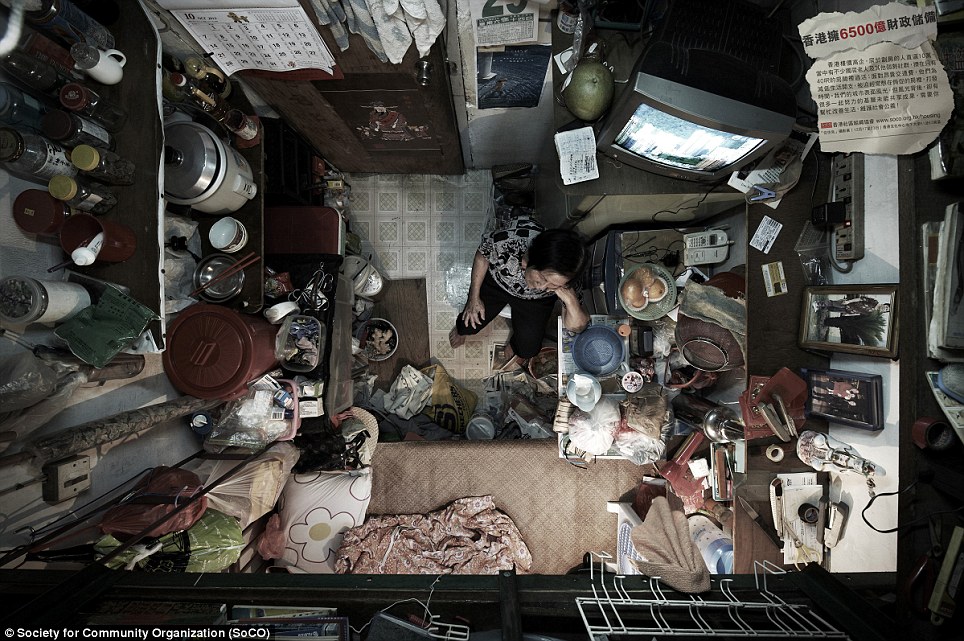Da Mail Online riprendo questa inchiesta su come si vive da poveri a Hong Kong. Immagini claustrofobiche che poco hanno da invidiare agli slums di altre parti del mondo o alla vita da carcerati. Qui siamo tra carcerati con libertà di uscire, certo. Ecco il servizio del Mail:
Hong Kong’s human battery hens: Claustrophobic images show how slum
families squeeze their lives into the tiniest apartments
- Bird’s-eye images released by social group documenting plight of poorest in one of world’s richest cities
- Group’s director: ‘Lurking beneath this prosperity is great inequality and a forgotten group of poor people’
- With a land mass of 1,104sq km and a population of 7 million, it is also one of the most densely populated
They are barely bigger than a toilet cubicle.
Yet these depressingly cramped spaces serve as a kitchen, living room, dining room, bedroom, pantry and everything in between for their cooped-up inhabitants.
Those unfortunate enough to live in these urban slums range from the elderly and unemployed to low-income families and singletons.
Their location? Hong Kong. One of the richest cities in the world.
These bird’s-eye images have been taken by the Hong Kong-based Society for Community Organisation (SoCO) in a bid to document the plight of the city’s most underprivileged people.
With a land mass of 1,104sq km (426 sq mi) and a population of seven million, Hong Kong is one of the most densely populated areas in the world.
As rent is so high – around HKD$90 (£8) per square foot a month – and the waiting list for public housing so long, many are forced to live in inconceivably small spaces to survive.
In one picture, a family-four have to share a double bed which barely leaves them room to move. The walls are covered from floor to ceiling in shelves piled high with food, clothes, toiletries and all manner of daily essentials.
On the top bunk, two youngsters, one of them asleep from exhaustion, lie next to a rucksack, school paraphernalia and a desk fan. Two others below do their best to carry on with their daily routine even though they can just about turn around.
n another room, which measures just 4ft by 7ft, a man is seen fast asleep. When he wakes, there is just about enough space to swing his legs out of the bed, but beyond that the only way he can walk is out of the door.
SoCO says the story is much the same for hundreds of thousands of Hong Kong’s poorest people. These images were taken in the districts of Sham Shui Po, Yau Tsim Mong and Kowloon City, but it’s a similar picture all 18 of the city’s regions.
The group’s director, Ho Hei Wah, told MailOnline: ‘Hong Kong is regarded as one of the richest intivar cream reviews cities in the world. However, lurking beneath this prosperity is great inequality in wealth and a forgotten group of poor people.
‘Hundreds of thousands still live in caged homes and wood-partitioned cubicles, while the unemployed, new-arrived families from China and children in poverty struggle for survival. SoCO’s underprivileged clients are increasing in numbers â while the cityâs wealth continues to accumulate.’
The city went through a period of unprecedented economic boom during the 1970s, but at the same time the then colonial government became riddled with rampant corruption.
Mr Ho said there was great poverty and the underprivileged, including boat people, resettlement estate residents and squatters, were overwhelmingly high in numbers.
SoCO was formed in the 1971 by a group of clergymen and other activists who foresaw the growing social injustices and campaigned to reign them in.
But more than 40 years later and after the reunification with China, Mr Ho says the poorest are still being neglected by those in power.
He added: ‘Faced with rapid changes in society, SoCO has continuously worked together with grassroots people to fight for a reasonable livelihood by upholding the principles of “equality for everybody”, “promotion of civil rights” and “implementing justice”.
‘Originally an underprivileged group of people has, in unison, become a stronger force to propel the reform of an unjust social system.
‘We will continue to soldier on with the underprivileged and hope more people will join forces with us to safeguard human rights and the rule of law, thus enabling the development of a caring and just society.’
From its earliest days as a British colony – after the First Opium War of 1839-42 – Hong Kong has served as a major centre of international trade.
During the 20th Century, the population was bolstered by large numbers of refugees, mostly from China, who helped launch a new role for the region as a manufacturing hub in which ‘Made in Hong Kong’ goods were exported throughout the world.
n recent years, as the economy of mainland China became less isolationist, Hong Kong evolved once again into a service-based economy.
By the 1980s, it had became an international financial centre and joined the world’s top 10 economies.
It was that shift from manufacturing to knowledge-based industry that has been main driving force for the area’s wealth disparity.
Since 1997, when Hong Kong was handed back to China, it has operated under the principle of ‘One Country, Two Systems’, which has allowed the city to retain a high degree of autonomy, including its capitalist system.
As such, it has done little to stem the widening gap between rich and poor.
In 2007, a Hong Kong Government census showed that the number of families earning less than HK$4,000 a month had increased by 80,000, while those on more than HK$40,000 had increased by 100,000.











